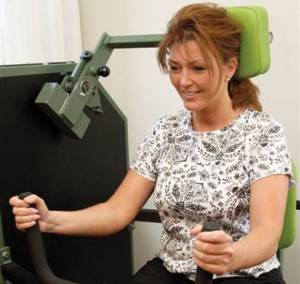By Jorgen Albrechtsen –


Remember that the purpose of the cardiovascular system is to supply certain nutrients that are needed by the muscles and to help remove the by-products of the consumption and utilization of these nutrients. Cardiovascular health is often confused with aerobic conditioning, the latter of which is always specific to a particular activity, such as running or stationary cycling. Cardiovascular health, by contrast, equates to the ability of the heart, lungs, and bloodstream to supply whatever the muscles need. According to an abundance of studies, the cardiovascular system receives tremendous stimulation and benefit from resistance exercise.
Training Pace
During training for osteoporosis sufferers about 25 years ago, it was discovered that a very slow movement of the weight gave unexpected high increases in muscle strength. A very slow movement was chosen in order to protect the porous bones as much as possible thereby avoiding injury.
Moreover, it subsequently turned out that this training method of 10 seconds of lifting and then 10 seconds of lowering gave 50% better results than the method previously used of 2 seconds of lifting and then 4 seconds of lowering. Using the slow movements, the inertia is eliminated.
It has turned out that movements of up to 5-6 seconds include the effect of jerk generated inertia, while movements of 8-12 seconds ensure the complete stimulus of the muscle without the effect of jerk generated inertia. For movements lasting more than 12 seconds, the muscles cannot be moved in a continuous movement.
– Ref. I.e.: Wayne Westcott et al: Effects of Regular and Slow Speed Training on Muscle Strength
Training Frequency
Already during the 1970’s, Arthur Jones (the founder of Nautilus and later on the MedX) demonstrated that one set to momentary muscle failure was optimal to achieve the best results. Such a set would encourage maximum muscle stimulation, and once this was achieved, any further activity would only draw on the body’s ability to rehabilitate without contributing to further results.
At the time, 10-12 different exercises were performed with one set of each made to momentary muscle failure. The repetitions were made slowly compared with otherwise normal practice (2 sec. when lifting and 4 sec. when lowering).
Today, we have better equipment, and it offers hardly any friction facilitating an effective implementation of the exercises when done in 10 seconds either way. This will increase the intensity considerably and means that personal and private training once a week is sufficient to achieve and maintain optimum results for the individual. Added to that are the Lower Back machine and all the related scientific research giving a whole new dimension to training.
Overview of Concept
On this canvas of scientific studies carried out on various patient groups as well as numerous normal, healthy performers of all ages from about 14 to 90+, the concept has been defined as follows:
1) Strength training of the large muscle groups in a time wise continuous series of 6 exercises.
2) Each exercise is performed using 10 seconds of lifting and 10 seconds of lowering.
3) The movement in each exercise is repeated about 4 – 7 times to reach voluntary muscle exhaustion. That is why each exercise takes between 1 1/2 and 2 1/2 minutes to complete.
4) Increase the weight progressively until one can perform the exercise for more than 2 1/2 minutes before reaching the momentary failure point, then increase the weight again by about 3-5%.
5) The whole training session will then take less than 20 minutes in total.
6) As the exercises are carried out very slowly and without jerks, muscles and tendons do not require the usual warm-up. Likewise, stretching after the exercises is not required either.
As the individual muscle group will only work for a short while, there will be no significant development of body heat. Along with a low room temperature (max. 68-70 degrees) and a working fan, the performer will enjoy a “pleasant training climate” and, in addition, the muscles will work more intensively.
For more information, see the website www.concept1010.us or call for a free introductory session: 239-325-1810.
Now 3 locations:
Downtown Naples, North Naples and Bonita/Estero
 Southwest Florida's Health and Wellness Magazine Health and Wellness Articles
Southwest Florida's Health and Wellness Magazine Health and Wellness Articles
